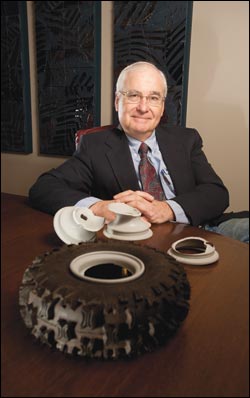Total Recall
By: Jack Zemlicka, [email protected]//January 10, 2011//

When attorney Victor C. Harding’s phone rings this time of year, there is a decent chance that it is someone with a question about a defective snowblower.
This despite the fact that Cleveland-based MTD Products Inc. issued a recall of about 130,000 snowblower tires more than five years ago because over-inflation could cause the plastic wheel rims to explode.
Since the recall, Harding said the first significant snowfall each year always prompts a flurry of calls and he has brought eight injury claims against MTD, three of which are still pending.
“I’m getting sick of doing these cases,” said the Warshafsky, Rotter, Tarnoff & Bloch attorney. “Yes, I’d like to put myself out of business and not have anyone get injured. The problem is, they keep coming along.”
Facetiousness aside, Harding and other personal injury attorneys thrive on cases in which accidents caused by defective products outlive a recall by years or even decades.
Generally, the three-year statute of limitations for filing a claim begins on the date of injury, but Cannon & Dunphy attorney Kevin R. Martin said there are exceptions.
The date of a recall and when a reasonable person should have known a product was defective also come into play.
“If you are bringing a snowblower case in 2010 and it was recalled in 2006, there is going to be a statute of limitations defense raised,” Martin said.
He represented Wisconsin residents in lawsuits against drug maker Merck & Co. for the painkiller Vioxx. Use of the drug allegedly doubled the risk of heart attacks and strokes.
The company recalled the drug in 2004 and agreed to a $4.85 billion settlement in 2007. Last year, the company completed payment of more than 3,400 claims to families of Vioxx users who died of heart attacks or strokes.
Martin said he still receives calls about Vioxx injuries, but doesn’t take any new cases due to the settlement, but also because it’s reasonable to expect that the date of the recall triggered the statue of limitations, which has since expired.
“I advise them that the deadline has passed based on the information we have and I advise them of their right to get an opinion from another lawyer,” he said.
But a statute of limitations defense isn’t necessarily going to insulate the manufacturer from liability.
Milwaukee personal injury attorney Lynn R. Laufenberg successfully brought claims against John Deere, which recalled a series of lawn tractors in the 1980s due to a design flaw that led to fires under the hood.
While the machines were manufactured in the 1970s, Laufenberg continued to successfully pursue claims into the late 1990s, because the statute of limitations for filing an injury claim didn’t begin until there was an accident, regardless of the age of the equipment.
 One of the reasons why those kinds of product liability cases have a longer shelf life is the difficulty for manufacturers to notify owners. For example, if a consumer fails to return a warranty card after purchase, companies can struggle to track down the owner in the event of a recall. Or, if the product is no longer the property of the original owner, a recall can easily slip by unnoticed.
One of the reasons why those kinds of product liability cases have a longer shelf life is the difficulty for manufacturers to notify owners. For example, if a consumer fails to return a warranty card after purchase, companies can struggle to track down the owner in the event of a recall. Or, if the product is no longer the property of the original owner, a recall can easily slip by unnoticed.
“I represented a family where the machine had changed hands several times and there was no way anyone was aware that there was a recall, much less the potential danger associated with the product,” Laufenberg said.
However, a single owner is more likely to become aware of a recall, depending on how aggressive the manufacturer is in advertising the defect.
“If an owner gets good information, doesn’t respond and then gets injured, it won’t mean there is no basis for claim,” Laufenberg said. “It may increase the likelihood of more significant contributory negligence imposed on the owner of the machine.”
Unlike faulty medical devices or drug recalls, which are funneled through health care providers, tractor and snowblower recalls don’t have an “intermediary,” Martin said.
In his experience bringing medical product liability cases, he said consumers are likely to find out about a recall sooner, because manufacturers notify doctors, who then notify patients.
“People have to go back to a physician for a refill,” Martin said. “It’s not like the user of a snowblower has to go back to the dealership for the next quart of oil.”
Harding estimated that of the 130,000 snowblowers recalled, there are still more than 20,000 snowblowers in circulation. Given that use varies from winter to winter, he said it could be another decade before injury claims tied to the machine finally disappear.
“These snowblowers will be around for 10 to 15 years and even if they are used 10 times a year, they still look brand new at that point,” he said. “So, I don’t see an end to these in the near future.”
Jack Zemlicka can be reached at [email protected].
Legal News
- Wisconsin joins Feds, dozens of states to hold airlines accountable for bad behavior
- Trump ahead of Biden in new Marquette poll
- Bankruptcy court approves Milwaukee Marriott Downtown ‘business as usual’ motion
- New Crime Gun Intelligence Center to launch in Chicago
- Arrest warrant issued for Minocqua Brewing owner who filed Lawsuit against Town of Minocqua
- Wisconsin Supreme Court justices question how much power Legislature should have
- Milwaukee’s Common Council now has the most African Americans, women and openly LGBTQ members ever
- Office of School Safety Provides Behavioral and Threat Assessment Management Training Ahead of 25th Anniversary of Columbine Shooting
- Wisconsin Supreme Court to hear arguments in Democratic governor’s suit against GOP-led Legislature
- Lawsuit asks Wisconsin Supreme Court to strike down governor’s 400-year veto
- Wisconsin man pleads not guilty to neglect in disappearance of boy
- ACS Selects University of Wisconsin Law School’s Miriam Seifter for 2024 Ruth Bader Ginsburg Scholar Award
WLJ People
- Power 30 Personal Injury Attorneys – Russell Nicolet
- Power 30 Personal Injury Attorneys – Benjamin Nicolet
- Power 30 Personal Injury Attorneys – Dustin T. Woehl
- Power 30 Personal Injury Attorneys – Katherine Metzger
- Power 30 Personal Injury Attorneys – Joseph Ryan
- Power 30 Personal Injury Attorneys – James M. Ryan
- Power 30 Personal Injury Attorneys – Dana Wachs
- Power 30 Personal Injury Attorneys – Mark L. Thomsen
- Power 30 Personal Injury Attorneys – Matthew Lein
- Power 30 Personal Injury Attorneys – Jeffrey A. Pitman
- Power 30 Personal Injury Attorneys – William Pemberton
- Power 30 Personal Injury Attorneys – Howard S. Sicula











